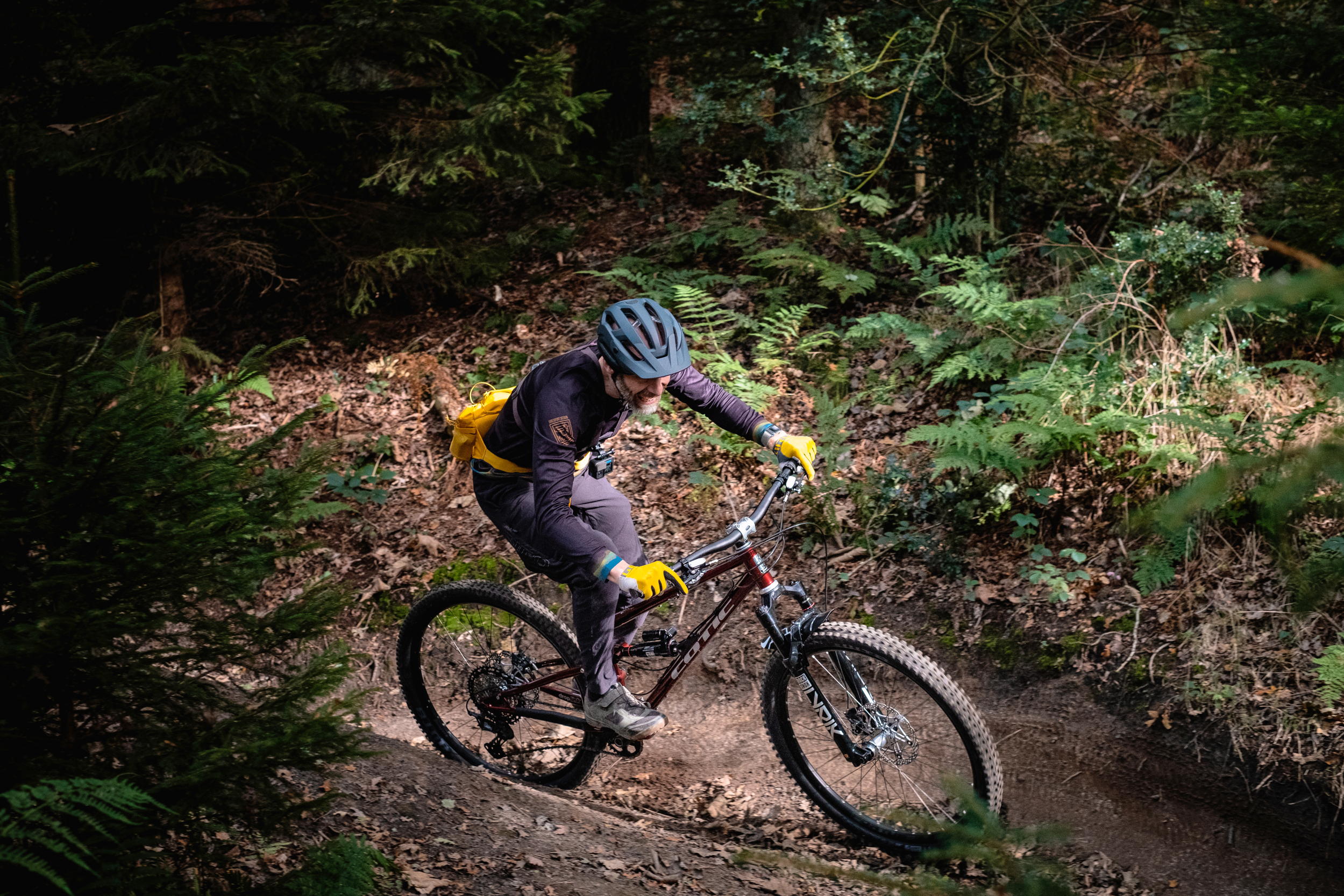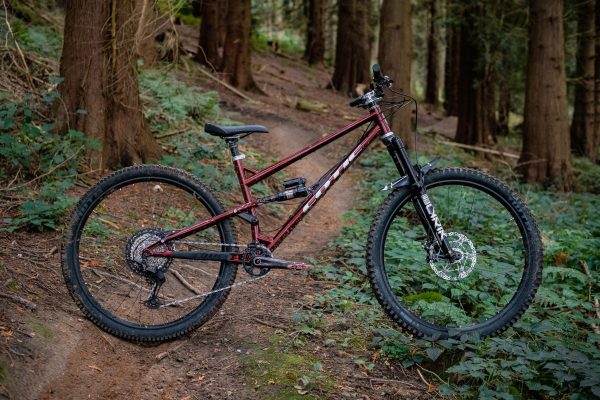Cotic’s steel sweet spot trail bike gets tougher, lower, more dynamic, and more Scottish.
Cotic Jeht 2 Gold XT first ride review
The Cotic Jeht trail bike propelled itself straight into a position as the UK brand’s most popular model, with sweet spot mid-travel suspension and sorted geometry. Although only lightly evolved, the new version feels like it’s been properly henched-up to tackle punishing park days, with a tougher, more grounded steel frame, and more suspension pop, putting it into contention among the best full-suspension bikes on the market. And now all the front ends are made in Scotland from custom recycled Reynolds steel, so there’s a double boost to the feel-good factor.
- Scottish made Reynolds steel front end
- 150mm fork, 140mm rear travel
- Evenly spaced, long dropper friendly ‘C’ sizing
- More progressive suspension
- Eco friendly and excellent value

The artisan frame gives helps the Cotic Jeht stand out in a sea of ubiquity.
Frame and geometry
Cotic has been evolving its Reynolds 853 steel tube sets for just shy of 20 years, and the Jeht mainframe is loaded with subtle details such as the ‘Ovalform’ top tube and custom butted seat tube. After previously splitting Scottish and Far Eastern manufacturing depending on the batch of frames, Cotic has now fully committed to a front end that’s immaculately crafted by Edinburgh artisans Five Land. Who also handle the two (gloss crimson and matt sage) luxurious paint options. Additionally, the Jeht 2 gets two small but significant structural changes. A straight gauge, rather than butted, 853 ‘HD’ down tube, and a bracing post above the BB that’s pleasingly parallel to the similar pipe between top tube and seat tube.

Reynolds 853 tubes are made from recycled steel here in the UK.
Despite the extra tube, and new down tube to increase strength, the frame hasn’t gained weight. At around 4.5kg it’s on par with alloy bikes of a similarly high strength, and not dramatically heavier than the actual weight of many carbon frames.
Linkages and other alloy hardware are machined into existence by Rideworks here in the UK, and everything is smoother and tidier than the slightly agricultural aesthetic of older Cotics. Chainstays are still offshore alloy, but with neat Syntace dropouts (no UDH yet) and the same heavy-duty main pivot block as the 170mm travel RocketMAX.

There’s a choice of shocks, but the RockShox Super Deluxe Ultimate felt ace on our test bike.
Apart from the rear chainstay, cables/hoses are all routed externally using bridge clamps. Bearings are top quality lifetime warranty Enduro Max units and there’s ample clearance for 29 x 2.5in tyres. Bottle/accessory mounts under the top tube and the down tube look awkward, but they do work, and a Restrap-made frame fit bag is coming soon. You even get a Datatag security tracker installed as standard.

Cable routing isn’t the sleekest, but it’s functional and saves time and stress when it comes to maintenance.
Using steel also significantly reduces the eco impact of the frame, as Reynolds uses 100% recycled steel, and the mainframe can be recycled itself at the end of its life. And the tubes themselves are now made in Birmingham, which is a lot closer than shipping them in from the Far East.

Still no UDH hanger on the Jeht.
Geometry still starts with a 64.5º head angle on all sizes, but Jeht now gets the same ‘C’ sizing protocol as the Cotic FlareMax and Rocket Max with more regular reach increases from 444mm to 520mm. Seat tubes are now shorter to work with longer drop seat posts. Steeper seat tube angles are size specific, but all sit close to the 76º mark. After years of sticking with tall bottom brackets for crank clearance on climbs, Cotic has lowered the BB drop by 5mm.
Suspension
It still uses a linkage-driven shock with a seatstay pivot, but the suspension dynamics have been changed. Progression rates have been increased across all sizes, and proportionately more on larger sizes to better support bigger riders. I rode the Jeht 2 with a RockShox Lyrik Ultimate fork at 150mm and RockShox SuperDeluxe rear shock. Stock ‘Gold’ level bikes will come with RockShox Pike Ultimate or Cane Creek Helm forks and RockShox Deluxe Select+ or Cane Creek DB IL shocks. You can pick a range of forks and shocks from Fox or Cane Creek on all bikes, rolling chassis or frame options though.

The Gold build gets an XT drivetrain but you can upgrade certain elements of the build.
Components
I rode a ‘Gold XT’ build with a selection of Hope upgrades, including Tech 4 E4 brakes with 200mm floating rotors, Fortus 30SC wheels, and Hope headset, bottom bracket, stem and seat collar. Cotic offers builds starting from the ‘Bronze’ Deore/SLX/RockShox Revelation level at £4,225 up to £6,999 for Platinum with XTR, Hope and Cane Creek eeWings titanium cranks. It also offers rolling chassis deals (from £2,895), or partial builds which you can complete with kit you already own, or frame and shock combos (from £1,799). Whatever way you go, it looks like remarkably good value considering the hand-built Scottish front end and top spec tube set.

Cotic’s Jeht gives its passengers a first class ride.
Performance
While the changes seem subtle both on paper and in the flesh, the Jeht has changed its on-trail character significantly. The lower, stiffer frame instantly feels more locked into the trail, as though it’s rolled up its sleeves ready for a proper brawl. With a mid level of compression support dialled into the shock and fork, there’s a precision and accuracy to the initial feel that’ll surprise a lot of people who presume steel is inherently soft and twangy in character. It certainly places it’s wheels accurately and holds them there with a lot more authority than any Cotic from of a couple of generations ago. Speaking to Cy Turner – founder and head designer at Cotic – that’s a very deliberate decision, and a reflection of how much harder people are riding ‘trail’ bikes now. Often taking them into places and bike parks that would have been DH bike and full-face mandatory territory not long ago.

The new Jeht feels a lot tougher than its predecessors.
The taut tune of the current RockShox dampers, and stiff, solid feel of the Hope wheels definitely emphasise the increased stiffness of the frame. It’s very notable that you’re now able to push kit like that to the limit on this bike, and I regularly pushed past the point where the High Grip WTB Verdict spike tyre on the front could hang on. Thankfully there was enough inherent stability in the LongShot geometry to slide those moments out without decking it, so I could stay eyes up and hunting for the next turn rather than going man down. The new C3 sizing fitted me like a glove from the first run, so it never felt like I was out of place or fighting to get back in control. Even when I accidentally hit a super steep corkscrew run I normally avoid – due to previous crashes on much bigger bikes – the Jeht felt super composed and took care of the terror without any stumble or stammer. On the same run I accidentally confirmed it’s increased strength by horribly casing a drop that destroyed a Cotic Flare a few years back, but the Jeht rolled out of it without a flinch, let alone a fold.

Despite its heft, the Jeht is surprisingly flighty.
While the tougher, tauter character inevitably means some of the skip, float and trail moulding ductility of the flexiest steel bikes has been lost, this is no dead ride. It’s certainly damped and remarkably quiet for excellent physical and psychological calmness, even when things get super janky across roots or rocks. There’s still enough vitality to give it a really alive, organic feel, helping to shrug off body blows through dug out braking sections or cased landings and/or launch out of corners.
The increased progression of the suspension not only gives it a more sensitive start stroke, but also more pop to play with. That makes the Jeht surprisingly easy to get off the ground for a 16kg bike, and I never had any sense I was being stung for excess baggage. While the rims are still pretty heavy, and the front tyre sticky and slow, the fast engaging Hope Pro5 hubs boost responsiveness too.
While overall mass, and the sticky spike front rubber of the test build, made climbing an eventual, rather than effervescent experience, the suspension itself is impressively stable under power. You might want to reach for the ‘firm’ switch if you insist on stomping out of the saddle on steep road climbs, but otherwise it’s fine being left open. I’d certainly leave it open on off-road climbs where the steeper seat angle meant grip was impressive, even with the Trail Boss rear tyre. The extra pipe above the BB and chunky chainstay head means there’s no sense of power being lost to frame flex either, so with a lighter build the Jeht would be a great power play/long day trail bike.
On a practical basis, I’d take the convenience of external cable/hose routing over internal rummaging any day, and having Enduro Max bearings as standard is a major longevity bonus.
Verdict
With the new Jeht it feels like Cotic has properly muscled in against the mainstream opposition, while keeping its signature style and steel ride vibe. It’s now tough and taut enough to take on the burliest carbon and alloy bikes in the ‘pushing components to the limit’ game, rather than shying away from the killer blows. Geometry, sizing and suspension is as good as anything else out there too. Thankfully it’s still got the smoothly organic, grippily damped character that separates it from the carbon and alloy masses on the trails. In an increasingly samey world of bikes, those points of difference feel even more valuable and visceral than ever. Those slim steel tubes still differentiate it aesthetically and ecologically too, especially now it’s primarily a UK-made bike. Considering the scale of the company, the amount of time and effort it invests in advocacy and community programs, its above-and-beyond reputation for customer service, and the premium Five Lands and Ride Works manufacturing, pricing is remarkably good too.
















